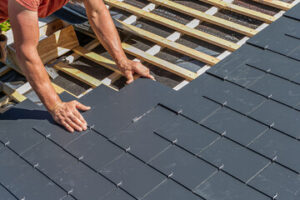Roofing Kalispell maintenance ensures that your roof continues to perform well. It also prevents leaks that can cause damage to insulation and drywall.

Minor repairs are typically inexpensive and easy to fix. They are important to make before they turn into major problems.
Large accessories such as chimneys, vents and skylights should be inspected for creosote buildup and to maintain proper ventilation. They should also be cleaned regularly to avoid clogs and water damage.
Flashing is a metal piece that is shaped to fit around roof features like chimneys, skylights and vent pipes. It creates a seal to prevent water from getting into the structure. Flashing can be made of copper, aluminum, galvanized steel or even lead. It is important to inspect roof flashing regularly because leaks can occur if it is worn out or damaged.
Metal flashing can rust, especially in areas with high salt exposure or acid rain. This rust weakens the flashing and can cause it to become loose. Over time, it can also create a gap where water can enter the building. When a flashing leak is allowed to get worse, it can result in damage to drywall, insulation and wood. In addition to rust, flashing can become warped and damaged due to weather and age.
The caulk used to seal the flashing is another item that should be inspected on a regular basis. The caulk should be replaced when it begins to crack and break apart. The flashing may also need to be resealed if it is showing signs of wear or damage.
In addition to inspecting the flashing, it is important to ensure that all roof features are properly secured and installed. For example, a shingle should be properly attached to the chimney flashing, or a pipe should be secured to the roof with metal flashing and a caulk. The inspector should make sure that all fasteners and nails are secure and that the shingles are not lifting.
It is also important to check for signs of clogged drains on the roof. This can be a sign that there is moisture buildup and condensation that will need to be addressed. In addition, the eaves should be checked to make sure that they are not blocked up with insulation or other items. This will hinder proper ventilation and can cause the growth of fungus and mold.
In addition to checking the flashing and roof features, the inspector should look for damage to the trusses or beams in the attic. This includes checking for sagging, rot, rust or peeling paint. The inspector should also check the pipe and equipment supports for rust, fungus and other structural damage.
Inspect the Gutters
Gutters play an important role in the drainage of water off a roof. They also help protect the roof, fascia, siding and foundation of the house from moisture damage. Regular inspections are needed to ensure that they perform these tasks. The first step is to look for signs of clogs and leaking. Clogged gutters can cause problems that are costly to repair.
To conduct a gutter inspection, you will need a ladder and some protective gear (gloves and a mask). Place a bucket or tarp underneath the ladder to catch debris. Next, you will want to climb the ladder and visually check the condition of the gutter troughs. It is best to do this while it is not raining, as standing water can be a sign of gutter problems. You should also inspect for signs of insect nests or rot in the gutter troughs and downspouts. Finally, you will want to look for any sections of the gutter that are inconsistent in height or slope and should be fixed.
Once you have inspected the gutters, you will want to clear any clogs by hand or use a hose to flush away smaller debris. You will then want to watch the flow of water to make sure that it exits the downspouts freely. It is a good idea to clean out the gutters twice a year, once in the fall and once in the spring.
Other things to look for during a gutter inspection include rust on downspouts and elbows; dents or other external damage on the gutters; and the presence of water in a basement or crawl space. A good roof maintenance routine will include inspections of the gutters, as well as the flashing and shingles. If you are not comfortable doing these repairs on your own, you should hire a qualified roofer to address them. This will save you a lot of money in the long run. Remember that small issues with the roof can escalate into major problems if left unattended. That is why it is so important to schedule roof maintenance on a regular basis.
Inspect the Shingles
The roof shingles should be in good condition with no bald spots or missing shingles. If the shingles are old and cracked, this may indicate that the roof is nearing the end of its life and that it’s time to replace it.
The inspector should look for signs of shingle deterioration, including curling, blistering and buckling. He will also check the gutters and downspouts for blockages, cracks and broken seams. Lastly, he will inspect the shingle granules (the sand-like material that covers asphalt roof tiles) for excessive amounts in the gutters. These are a sure sign that the shingles are reaching the end of their useful life and will soon need replacing.
Another part of the inspection involves checking the shingles for signs of moisture damage, which can cause leaks. He will look for dark stains on the shingles, which may be lichen, moss or blue-green algae. These can be removed with a roof cleaning chemical, but this is best done by a roofing contractor who will be able to get up on the roof and apply the chemicals properly.
He will also check the roof for sagging areas, which can be caused by water damage to the underlayment or shingles. He will also examine the shingles for exposed nails that need to be hammered back in place. The shingles should overlap each other by at least 1/2 inch.
The inspector should also examine the gutters and downspouts, soffit and fascia for any signs of leaks or deterioration. He will also look at the vents and chimneys to see if they need repairing or sealing. He will also inspect the attic for leaking or moisture damage. He will also use a flashlight to check the ceiling and beams for water stains, which can be caused by a damaged roof. He will also check the homeowners insurance policy to ensure that it is up to date and to provide advice on navigating an insurance claim for storm damage. He will also advise the homeowner on how to protect their property from future weather damage by conducting a regular roof inspection.
Inspect the Chimney
The chimney of a home is a major part of the roof, and it should be inspected on a regular basis. A good roof inspection should include a thorough examination of the chimney and the flashing that is attached to it. This is an important step in preventing water leaks that can be caused by problems with the flashing.
The flashing is a metal sheet that connects the chimney to the roof line. It is designed to provide an airtight seal, but if it becomes damaged or corroded, the flashing can allow water to leak into the roof underlayment. In order to prevent this from happening, it is important to inspect the flashing regularly and keep it in good condition.
Chimneys are essentially big holes in the roof, and that creates a vulnerable spot for moisture to enter. In order to prevent this, chimneys need flashing that goes around the edge of the hole. This flashing is a metal sheet that is sealed at the edges where it meets the shingles. In order to protect the flashing from moisture, it is also important to inspect the caulk that seals this area on a regular basis. This caulking can become damaged or deteriorated over time, so it is important to remove the old caulk and replace it with fresh caulk in order to ensure that the flashing is properly protected from moisture.
Another important aspect of a chimney is the crown, which is a cement shoulder at the top of the chimney that sheds rainwater. The chimney crown should be in good condition and free of cracks, dents or other structural damage. The chimney should also be in proper alignment with the roof and have sufficient clearances from combustible materials. In addition, the chimney should have a spark arrestor or cap in place to prevent embers from escaping and causing a fire.
In addition to a roof and chimney inspection, it is also important to inspect the attic, attic insulation and crawl space on a regular basis to make sure that there are no signs of moisture damage. Inspecting these areas will help to prevent expensive repairs in the future, and it is a great way to prepare your house for the winter.
